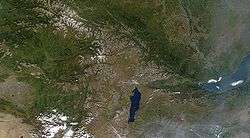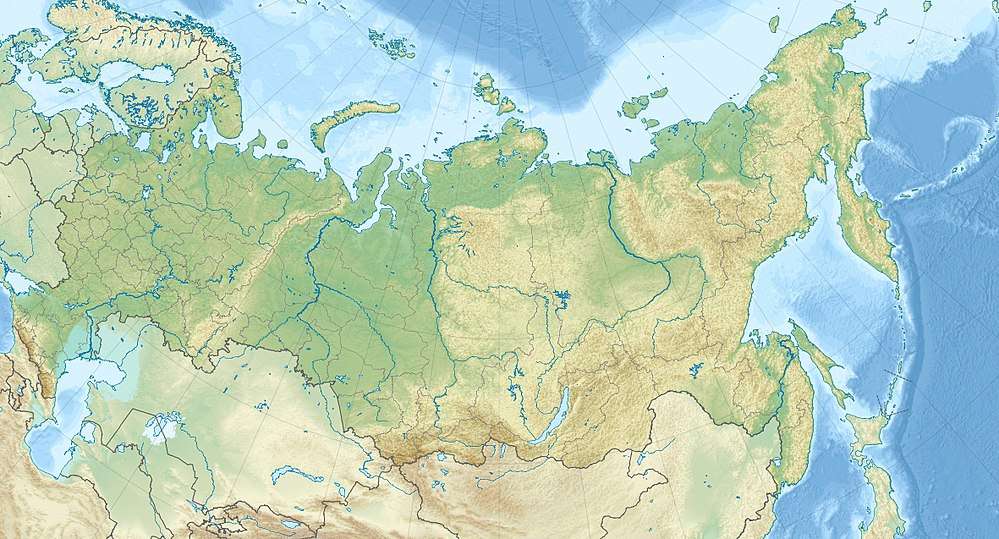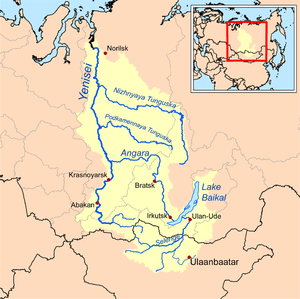Soyot
The Soyot people live mainly in the Oka region in the Okinsky District in the Republic of Buryatia, Russia. According to the 2010 census, there were 3,608 Soyots in Russia. Their extinct language was of a Turkic type and basically similar to the Tuvans. Their language has been reconstructed and a textbook has been published. The language is currently taught in some schools in Oka. The Oka River, the largest river flowing down from the Western Sayans into the Angara is called the Ok-hem meaning "an arrow-river" by the Soyots of the Oka River basin.[2]
.svg.png) Okinsky District of Buryatia | |
| Regions with significant populations | |
|---|---|
| 3,608[1] | |
| Languages | |
| Buryat language | |
| Religion | |
| Tibetan Buddhism | |
| Related ethnic groups | |
| Buryats, Tuvans | |
They live dispersed among the Buryats and now speak the Buryat language.
Historical context
According to Larisa R. Pavlinskaya, a Russian ethnographer based in St. Petersburg, Russia, "The ancestors of the Soyots (and of the closely related Tofa, Tozhu, and Dukha) were proto-Samoyedic hunter-gatherers who arrived in the Eastern Sayan region from Western Siberia at the end of the third millennium BC and the beginning of the second millennium BC."[3]
In 1726 Tunka Valley Buryats spoke of a people who self-identified as Soyot but who the Buryats called Kosogol Urianghai. At that time the Soyot herded reindeer on the upper Irkut River, a river in the Buryat Republic and Irkutsk Oblast of Russia to Lake Khövsgöl, Mongolia.[4] Approximately 350–400 years ago, the Soyot people moved to Buryatia from the area of Khovsgol Lake.[5]:15[6] The traditional lifestyle of the Soyot people, like others in the Taiga group, was characterized by reindeer-breeding and hunting but by 2009 most people were living in villages.[5]:17
In 1940 the Okinsky Region was designated as an aimag and officially recognized all residents of the Okinsky region as Buryat. Soyots lost their official identity as an ethnic group until 2000.[3]
Reindeer herding
Bernhard Eduardovich Petri, (1884-1937) Professor of ethnology at Irkutsk University, member of the British Anthropological Society, the USSR State Academy of the History of Material Culture, and full member of the American Anthropological Association undertook research with the indigenous peoples of Siberia. In 1926 Petri led the first anthropological expedition into the Soyot reindeer-herding region.[3] Petri described a difficult period in Russian history claiming that Soyot reindeer herding was a "dying branch of the economy."[3][7] "After the civil war, Petri was involved in "planning changes in the economic lives of minority peoples of the greater Altai-Sayan and Buryatia regions, including the nomadic reindeer-breeding Tungus (Evenki) and the Soyot and Tofalar."[8] He was wrongfully accused of "espionage for the British and German intelligence services, and of anti-Soviet activity, specifically establishing contacts with nationalistic representatives of the Buryat people, so-called Pan-Mongols" and executed in Irkutsk in 1937.[8] Pavlinskaya argued that "later research and data collected from Soyot elders show that the herding tradition easily overcame the period's difficulties and endured until the middle of the 20th century, when the government interfered."[3]
Sev'yan I. Vainshtein (1926–2008), a Russian ethnographer, archaeologist, historian and explorer of Siberian and Central Asian peoples and professor at the Institute of Ethnology and Anthropology of the Russian Academy of Sciences in Moscow, undertook expeditions to study reindeer-herders including the Soyot and published a number of works on the subject.[9] Vainshtein argued that Sayan reindeer herding "is the oldest form of reindeer herding and is associated with the earliest domestication of the reindeer by the Samoyedic taiga population of the Sayan Mountains at the turn of the first millenium [sic] A.D...The Sayan region was apparently the origin of the economic and cultural complex of reindeer hunters-herdsmen that we now see among the various Evenki groups and the peoples of the Sayan area." The Sayan ethnic groups still live almost exclusively in the area of the Eastern Sayan mountains.[10]
In 2000 reindeer peoples of Mongolia and Russia were working on collaborative efforts to rebuild reindeer-herding.[11]
Plumley suggested that the Soyot of Buryatia's Okinsky Region, the Tofalar of Irkutsk Oblast, the Tozhu Tuvans of the Republic of Tuva in Russia, and the Dukha of Mongolia's Hovsgol Province, who are "cultures of reindeer-habitat" in Central Asia may well "have traded, inter-married and related across the breadth and width of the Sayans."[11]
Though linguists may disagree on the nature of the differences between these peoples, the facts remain that their linguistic backgrounds are Turkic in origin, that their ecological habitats and the reindeer they raised nomadically are essentially the same. As the breadth of this region of the Sayans and into Hovsgol of Mongolia covers a distance of less than 800 kilometers – and the annual range territory of reindeer herds can be as much as several hundred kilometers in and of themselves – it is very possible that these people have traded, inter-married and related across the breadth and width of the Sayans – and that their languages and ancestry are all closely related to the old Tuvan language and possibly original heritage.
— Plumley 2000
Collectivization in the Union
| Soyot settled way of life | |
|---|---|
 Lake Khövsgöl (bottom center, Mongolia), Lake Baikal, and the Sayan Mountains | |
 | |
| Location | Buryatia, Siberia |
| Coordinates | 52°31′N 99°49′E |
During the period of collectivization in the Soviet Union, enforced under Stalin between 1928 and 1940, the Soyot and other Siberian inhabitants were forced into a settled way of life with socialistic enterprises replacing reindeer husbandry. The Soyots were moved to Sorok, Khurga, Bokson and Orlik, the administrative center of Okinsky District. Many were moved to cattle-breeding farms and they switched to Buryat-style husbandry.[12]
Ossendowski's accounts of visiting the Soyots in the 1920s

Oka River is a tributary of the Angara River. In the early 1920s, Dr. Ferdinand Ossendowski, a scientist and writer, traveled through the traditional lands of the Soyot during the Russian Revolution and published a book entitled Beasts, Men and Gods in which he described his experiences.[13] In 1920 Ossendowski narrowly escaped being arrested by the Red Army who surrounded his house in the Siberian town of Krasnoyarsk, on the shores of the River Yenisei. He fled into the forest and lived for a while in the taiga along the shores of the Yenisei River. He and his companions followed the Tuba and Amyl Rivers to the Sayan mountains, where Urianhai, the northern part of Mongolia, begins. Urianhai is on the head waters of the Yenisei.[13]
After three days we crossed the northern ridge of the Sayan chain, passed the border river Algiak and, after this day, were abroad in the territory of Urianhai. This wonderful land, rich in most diverse forms of natural wealth, is inhabited by a branch of the Mongols, which is now only sixty thousand and which is gradually dying off, speaking a language quite different from any of the other dialects of this folk and holding as their life ideal the tenet of "Eternal Peace." Urianhai long ago became the scene of administrative attempts by Russians, Mongols and Chinese, all of whom claimed sovereignty over the region whose unfortunate inhabitants, the Soyots, had to pay tribute to all three of these overlords.
— Ossendowski 1922
The Soyots helped Ossendowski and his companions escape. He appreciated their hospitality.
The inhabitants of Urianhai, the Soyots, are proud of being the genuine Buddhists and of retaining the pure doctrine of holy Rama and the deep wisdom of Sakkia-Mouni. They are the eternal enemies of war and of the shedding of blood. Away back in the thirteenth century they preferred to move out from their native land and take refuge in the north rather than fight or become a part of the empire of the bloody conqueror Jenghiz Khan, who wanted to add to his forces these wonderful horsemen and skilled archers. Three times in their history they have thus trekked northward to avoid struggle and now no one can say that on the hands of the Soyots there has ever been seen human blood. With their love of peace they struggled against the evils of war. Even the severe Chinese administrators could not apply here in this country of peace the full measure of their implacable laws. In the same manner the Soyots conducted themselves when the Russian people, mad with blood and crime, brought this infection into their land. They avoided persistently meetings and encounters with the Red troops and Partisans, trekking off with their families and cattle southward into the distant principalities of Kemchik and Soldjak. The eastern branch of this stream of emigration passed through the valley of the Buret Hei, where we constantly outstrode groups of them with their cattle and herds.
— Ossendowski 1922
While in Urianhai, Ossendowski met Ta Lama, Prince of Soldjak and High Priest of the Buddhist Temple whose wife had red eyes. After he healed her eyes, the Prince "ordered one of the Soyots to guide their party to the Kosogol" Lake Khövsgöl. This was near the Tannu-Ola mountains.[13]
Their Soyot guide took them through the Ulaan Taiga and the Darkhad Valley where they met Soyot herdmen rapidly driving their cattle over the Darkhat plain toward the northwest into Orgarkha Ola. They communicated to us very unpleasant news. They were fleeing the Bolsheviki from the Irkutsk district who had crossed the Mongolian border and captured the Russian colony at Khathyl on the southern shore of Lake Kosogol and were continuing their advance.[13]
A Norwegian scientific expedition, led by Orjan Olsen, H. Printz, Anders K. Olsen, Fritz Jensen (Norway) and J. E. Gustschin (Russia) in the early 1910s provides information on the customs of these people before they were completely assimilated to the Buryats. The ethnographic data and photographs collected by these scientists were published by Olsen in the book: "Et primitivt folk de mongolske rennomader" (Cappeln, 1915). There is a Spanish edition: "Los soyotos, un pueblo primitivo. Nómadas mongoles pastores de renos" (Calpe, Madrid, 1921). With all its shortcomings (the book is flawed with the eurocentrism of its age), it is probably the best study of these isolated people before they adapted to the larger Buryat culture. It includes a short list of Soyot words, several dozen photographs and a fortunate preserved account of a Soyot shamanic tale of divination, along with a detailed account of both shamanic and lamaistic rituals among these people (both Buddhism and native animism syncretically coexisted at the time of the expedition).
Rassadin and Soyot as an endangered language
According to Valentin I. Rassadin, the Soyots spoke their own language fluently in the 1920s.(Rassadin 1996:10-22).[5]:16 Many Soyot married into the larger culture, the Buryats. By 1996 the language was almost lost (Rassadin 1996:10-22).[5]:16
Shamanism
Among the various Soyot cultures, the central Soyot groups, keeping cattle and horses, show Khalkha-Mongolian phenomena in their shamanism,[14]:226 the shamanism of Western Soyots, living on the steppe, is similar to that of Altai Turkic peoples.[15] A shaman story narrates contacts between Soyots and Abakan Turkic peoples in a mythical form.[14]:62–63 The Karagas and Eastern (reindeer-breeding, mountain-inhabiting) Soyots have many similarities in their culture[14]:242 and shamanism.[14]:164 It was these two cultures who presented some ethnic features, phenomena lacking among neighboring Turkic peoples [14]:198,243 In a Soyot shamanic song, sounds of bird and wolf are imitated to represent helping spirits of the shaman.[14]:203 According to Rassadin, Buryat Buddhist lamas attempted to put an end to Soyot shamanism (Rassadin 1996:10-22).[5]:16
In 2000 People's Khural (Grand Assembly) of the Republic of Buryatia changed the name of the Okinsky Region to the Soyot National Aimag at the request of government of the Okinsky Region.[3] In 2000 the Soyot succeeded in restoring their name and identity as one of the officially recognized Indigenous small-numbered peoples of the North, Siberia and the Far East by decree of the Russian Government.[16]
External links
See also
References
- Russian Census 2010: Population by ethnicity (in Russian)
- "Okinsky district", Tourist Buryatia, pp. 45–47, 2009, retrieved 30 December 2014
- Pavlinskaya, Larisa R. (Spring 2003), "Reindeer Herding in the Eastern Sayan- A Story of the Soyot", Cultural Survival Quarterly, The Troubled Taiga, 27 (1), retrieved 30 December 2014
- Eriksonas, Tomas (May 2012). On the Phonology and Morphology of the Taiga-Sayan Tuha Language. The 4th International Turkish Research Symposium. Hacettepe University, Ankara, Turkey. Retrieved 28 December 2014.
- Khabtagaeva, Bayarma (2009). Mongolic Elements in Tuvan. Foreign Language Study. Wiesbaden: Harrassowitz Verlag. pp. 341 pages.
- Rassadin, V.I. (2005), O.A. Povoroznyuk, "The Soyot language", Department of the North and Siberia, IEA RAS, Endangered languages of indigenous peoples of Siberia, retrieved 28 December 2014
- Petri, B.E. (1927), Anthropological Research into the Small-Numbered Peoples of the Eastern Sayan Mountains (Preliminary Findings), Irkutsk
- Sirinaa, A. (2003). "Bernard Eduardovich Petri: Forgotten pages in Siberian ethnography". Anthropology & Archeology of Eurasia. Moscow: Taylor & Francis. 42 (2): 71–93. doi:10.2753/AAE1061-1959420271.
- Vainshtein, Sev'yan I. (1971), "The Problem of the Origins of Reindeer Herding in Eurasia, Part II: The Role of the Sayan Center in the Diffusion of Reindeer Herding in Eurasia", Sovetskaya Etnografiya, 5: 37–52
- "Evenki Reindeer Herding: A History", Cultural Survival, retrieved 30 December 2014
- Plumley, Daniel R. (June 2000), "Requiem or Recovery: The 21st Century Fate of the Reindeer-Herding Peoples of Geographical Central Asia", Totem Peoples Preservation Project, Cultural Survival Inc., Republic of Tuva, archived from the original on 19 January 2015, retrieved 31 December 2014
- "Ethnic groups", Arctic Network for the Support of the Indigenous Peoples of the Russian Arctic, Indigenous Peoples of the Russian North, Siberia and Far East, Tromsø, Norway, retrieved 28 December 2014
- Ossendowski, Ferdinand (1922). Beasts, Men and Gods. Lewis Stanton Palen. Retrieved 29 December 2014.via Project Gutenberg
- Diószegi, Vilmos (1960). Sámánok nyomában Szibéria földjén. Egy néprajzi kutatóút története (in Hungarian). Budapest: Magvető Könyvkiadó. The book has been translated to English: Diószegi, Vilmos (1968). Tracing shamans in Siberia. The story of an ethnographical research expedition. Translated from Hungarian by Anita Rajkay Babó. Oosterhout: Anthropological Publications.
- Diószegi 1960:238
- Official is attached to: Decree of the Russian Government Nr 255 "On the Unified Register of Native Small-Numbered Peoples of the Russian Federation", 24 March 2000 (Постановление Правительства РФ от 24 марта 2000 г. N 255 "О Едином перечне коренных малочисленных народов Российской Федерации (in Russian)) http://base.garant.ru/181870.htm